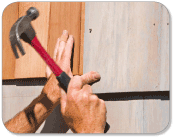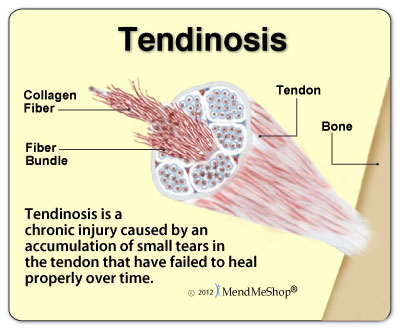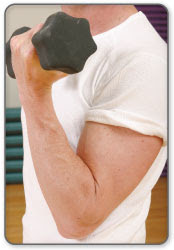Golfer's elbow is less common than tennis elbow but still accounts for 10 to 20 percent of all epicondylitis cases. Golfer's Elbow can affect anyone who uses their hands, wrists and fingers to wrap around instruments, type on keyboards, or grip objects (golfers, pitchers, racquet players, small parts manufacturers, office workers, lab technicians, hygienists, carpenters, wood choppers). It is most often a result of forceful contractions and overuse.
"[Golfer's Elbow] is highest among subjects ages 45 to 64 and more common in women compared to men. In certain occupations, the prevalence may be as high as 3.8% to 8.2%. Three out of four cases are in the dominant arm."
Most cases of medial epicondylitis are managed nonsurgically, although it is less common than lateral epicondylitis and more difficult to treat. [9] Initial management should include cessation of offending activities including decreasing their volume, frequency, or intensity. The provider should recognize that this may not always be possible depending on the patient's occupation. For example, a professional athlete or laborer may not be able to afford to take time off.
Kiel, John, and Kimberly Kaiser. 2018. "Golfers Elbow". Statpearls Publishing. https://www.ncbi.nlm.nih.gov/books/NBK519000/.
Tennis elbow and golfer's elbow are a result of vigorous use and movements or overstraining of the forearm muscles that move your fingers, hand, wrist and forearm. Overuse of your muscles really depends on how long you do something and how much effort you exert doing it. The constant tugging at the point of attachment on the outside of your elbow (lateral epicondyle) or the inside of your elbow (medial epicondyle) can cause these tendons to become inflamed and strained. Your muscles and tendons can then become irritated which can result in weaker tendons, tiny tendon tears and development of scar tissue and/or calcium deposits. The development of scar tissue will put pressure on your soft tissue and nerves, and interrupt the blood flow to this area; this can be very painful.
If golfer's elbow pain is due to a deterioration of the tendon (tendinopathy), it can take from two to six months to fully recover. Many cases of medial epicondylitis become chronic problems (just like lateral epicondylitis) that progressively get worse if the sufferer continues performing the causal activity that started the condition in the first place. When you do this, your body definitely indicates there is a problem as the area will continue to generate a lot of pain.
Over time with overuse, your muscles and tendons can become irritated which will result in weaker tendons, tiny tendon tears and development of scar tissue and/or calcium deposits. The development of scar tissue will put pressure on your soft tissue and nerves, and interrupt the blood flow to this area. Scar tissue is tough to get rid of and can cause significant pain over a long period of time. The application of heat when combined with PT and a conservative treatment plan will aid most patients in a reduction of scar tissue, while simultaneously increasing growth of healthy tendon and muscle tissue. By following a conservative treatment regimen, most sufferers of golfer's elbow can rid themselves of this persistent injury and get back to a normal pain free lifestyle faster than they would expect.
When we identify a "risk factor" what we are saying is that undergoing this activity (or profession) will elevate the risk that you might incur Golfer's Elbow. Generally, risk factors are identified that put you in a position where you either have a high likelihood of acute trauma or repetitive stress to the tendons and muscles attached to the medial epicondyle.
Traditional risk factors for golfer's elbow include actions like:
Modern day life in many ways has changed drastically over the last decade or two. The odds of your workday involving long periods at a computer station are higher than ever and the medical community is definitely seeing a rise in injuries due to frequent computer and mobile phone usage.
Users should know that using a keyboard and mouse causes their arms to be held in a tense posture - especially the forearms and wrist. Golfer's Elbow - when caused by keyboard and mouse usage - will arise most commonly in right handed people, as they typically are forced to keep their right elbow away from their side when using a mouse. This is usually due to the extended size of keyboards that have a number pad (and/or function pad) on the right side. This means that to use the mouse to the right of the keyboard, it has to be positioned too far right for the right elbow to be comfortable, and in such cases increases your risk of contracting golfer's elbow. A solution to this would be to use a keyboard without the extra keys on the right.
If you are sitting at a desk, put both of your hands on the desk with palms facing downward - we will call this "Position A". Take note of the position and the light awkward feeling that this position produces. Now, rotate your hands outward so that your thumbs are pointing upward and the outside flat of the hand is resting on the desk - we will call this "Position B". Take note of the difference in the feeling and tension in the wrist and forearm when changing to the new position.
If the results of your small experiment went the same as mine, you will overwhelmingly agree that Position B is a much more natural position. The reasons for this are fairly straightforward, as the two bones connecting your wrist to your forearm are twisted when in Position A. When your hands/arms are in Position B, the bones are straight, and are in what is termed a "neutral" stance. This is why specialists in the ergonomic field recommend using a vertical mouse instead of a standard mouse, as the vertical mouse allows you to maintain a "neutral" stance in your arm.
There is a posture checklist that should be adhered for long term workstation users. We have highlighted areas in the list that is specifically related to epicondylitis:
There can be different factors leading to a re-injury of your medial epicondyle, but in most cases, the strongest reasons are:

Activities - If your household, workplace, or recreational activities involve significant repetitive movement of your wrist, forearm, upper arm, and/or shoulder you are at risk for developing Golfer's Elbow. Some common activities that can cause Golfer's Elbow include (but are not limited to): painting, house cleaning, playing an instrument, racquet sports, throwing sports (ie. baseball pitchers), weightlifting, heavy lifting, frequent use of a computer (or typing), and/or shaking hands frequently.
As you can see, its not just professional athletes or people with physically demanding jobs who suffer from Golfer's Elbow.
Actively moving your arm for long periods of time can cause a lot of stress to be exerted on your elbow. Repeated movements gradually increases the stress placed on muscles.If you don't give your body a chance to rest and regain strength, stronger muscles (like the ones in your shoulder) have no choice but to transfer energy to less capable structures (such as the muscles in your hand or wrist). Weaker muscles cannot handle the impact stronger muscles can. As a result, they begin to strain and even tear.
It is important that you allow your body to rest between periods of exertion or repetitive movement. Fatigue in your muscles can lead to bad form, or overuse. You body is an amazing thing! It is constantly trying to heal itself and perform at its fullest capabilities. When you don't allow your body to rest and push yourself beyond your physical limitations, chances of becoming injured are quite high.
Your tendons attach your forearm muscles to the bone of your elbow. When high levels of stress are exerted on your forearm, tendon fibres stretch beyond their limits. If this action is repeated over and over again, tendon fibers lose their strength and elasticity. They can become disorganized and tangled. If repeated long enough or with too much stress exerted, your tendon fibres may even begin to tear.
These small tears cause inflammation in the area of your elbow called the epicondyle ( the bony bumps on the inside (medial) and outside (lateral) of your elbow where the tendon attaches the forearm muscles to your elbow bone ). You elbow may become swollen, bruised, or disfigured. Your elbow joint is a very small complex structure and doesn't handle swelling well. Swelling will limit blood flow and possibly put pressure on the ulnar nerve - this can cause tingling and/or numbness in the wrist and hand. Micro tears and swelling can cause mild discomfort to intense pain. The limited blood flow can restrict your body's ability to heal. If not treated, your tendon will begin to deteriorate. It can take months for you to fully recover.
If you repeatedly injure your tendon without proper treatment and recovery, scar tissue will form. Scar tissue is weak and inflexible tissue that hardens around the tendon without giving it any support or strength. Scar tissue will never heal into healthy, mature, strong tissue. Scar tissue will put pressure on your soft tissues and nerves. It interrupts the blood flow to the areas of your elbow causing pain and delaying recovery. It is important to prevent the growth of scar tissue with conservative treatments.
This is why it is very important to seek medical advice when you've had an accident or injury. Your doctor will be able to recommend the best course of action for treating your tendon injury using cooling and heating treatments. If there is little swelling, as is often the case with Golfer's Elbow, we recommend the application of an Elbow as this will become a significant aid in boosting circulation in the area as well as helping reduce risk of tissue reinjury. To view more about how to treat Golfer's Elbow, go here.

Age is always a factor when it comes to injury. As we become older, our tendons begin to weaken and eventually break down. By not training our bodies or allowing repetitive injuries, we speed up this process.
If you have read a few pages on this website, you probably know that Golfer's Elbow is all about tendons - damaged tendons that attached to the medial epicondyle to be exact. So when we talk about aging and its effects on Golfer's Elbow, we are really talking about the effect that age has on tendons in the forearm.
Over time, repeated damage to your tendon can cause you to develop a condition called 'Tendinosis'. This means that your tendon becomes unable to ever heal fully. Age and repeated injury without proper treatment can cause the breakdown of your tendon.
Your body is an amazing organism and has all of the tools to heal itself. However, healing your tendon can take a very long time. It is unrealistic to expect anyone to put their life on hold for weeks or months. Without the proper treatments, your tendons will thicken with weak, inflexible scar tissue.
If you are experiencing a deterioration of the tendon (tendinopathy), it can take from two to six months to fully recover. Many cases of medial epicondylitis become chronic problems that progressively get worse if the sufferer continues performing the causal activity that started the condition in the first place. When you do this, your body definitely indicates there is a problem as the area will continue to generate a lot of pain.
Only you can prevent injury. Take steps before you injure your body to avoid spending valuable time in recovery instead of at work, with your family, or your favorite activities.
It is important that you speak to your doctor about the recovery and prevention options available to you.

Most people we deal with tell us these scenarios have happened to them many times in the past. The real challenge is how to achieve a full recovery, quickly, without causing further damage (re-injury). This goal is even more complicated by the fact that you have to use your arm / elbow for almost everything in everyday life.
To go to our Golfer's Elbow Treatment page, go here
The best option we came across in our research to accomplish true healing of elbow soft tissue injuries is the Elbow TShellz Wrap®. Use of this device results in a dramatic increase in blood flow to the injured tissues located deeper within the body - all in a non-invasive manner.
Using the TShellz Wrap® is truly a unique experience. Within moments of applying a treatment to your injured elbow, you can feel the healing sensation due to the increase in blood flow deep within the area. During a treatment, and for quite some time after you finish, the treated area will feel relaxed and less painful. It's a very soothing sensation and extremely effective.
The most common question we receive from individuals prior to purchasing is - how many times a day should I be using my elbow wraps and when should I be using them? While treatment plans will differ for each individual and their specific injury, there are general guidelines that should be adhered to.
The Elbow TShellz Wrap® would then be used:
Your body can heal itself and it's the blood in your body that makes it all happen. Your blood is how everything that's good inside of you is transported directly to your injured elbow tissue. Your blood carries oxygen, nutrients and water right to the source of your injury and pain. Bringing proper blood flow to your injured elbow is essential for healing.
The only way to get Circulatory Boost through daily treatments at home is through the application of an Elbow TShellz Wrap®.
Regular treatment with the TShellz Wraps® will ensure:
Your environment plays a huge part in the health of your body. Using tools that are properly fitted and weighted to your body and abilities will help you perform with success and avoid injury.
Young athletes with improper training are at significant risk of suffering from Golfer's Elbow symptoms. When starting a new job, activity, or exercise routine, it is important to learn and understand the best techniques for you to achieve your tasks and goals.
It is important for athletes to have their techniques and equipment checked by professionals for the best fit and performance. Why use movements or tools that don't give you the best opportunities for success?

Just like athletes, workers with physical jobs or people performing repetitive tasks should refer to occupational therapists. These specialists understand how the body works and which movements should be avoided as they can lead to injury.
Over extending your arm while painting can cause an injury just as easily as an improper back hand swing. It is important to understand that your body is a complex network of connected structures. When using wrong muscles, improper form or positioning during work effort, you put your body at elevated risk for injury.
Maintaining your general health and fitness can help you prevent injury.
Training your body to perform the ways you need it to will decrease your risk of injury. An untrained body is more likely to make movements using awkward motions where force is improperly handled by your body mechanics. This will cause stress hotspots which will definitely be more likely to damage soft tissue in the body, leading to long term injury.
It is important to remain physically active as this will keep your soft tissue more healthy and flexible. The health of your whole body contributes to the health of the individual parts. Maintaining a healthy weight and overall level of fitness through regular activity and healthy eating will increase your body's ability to avoid injury.
Lack of activity can cause muscles to become weak and unsupported. Without strong muscles your body places the stress on weaker structures like joints. Strong muscles help maintain a strong body, evenly distributing weight and forces to the areas that can handle it properly.
Remember to drink fluids and rest. Resting your body will help reduce fatigue in your muscles. Energized muscles are strong and will help you complete tasks efficiently and effectively.
Click HERE to Go To Our Online Store We take all major credit cards and Paypal.
If you have questions, call our office at 1-866-237-9608 (toll free continental US).
We are currently offering FREE SHIPPING and a 60 day trial period on all our Wraps.
Product Advisors are available 9:00 am to 5:00 pm Eastern Standard Time Monday to Friday.
I want to learn more about TShellz Wrap® Circulatory Boost
I want to learn more about Ice & Heat: Which Is Better For Treatment?
I want to learn How To Get Rid of Tennis Elbow
I want to learn How To Get Rid of Golfers Elbow
I want to learn more about Elbow Anatomy
I want to learn more about Elbow Surgery
I want to learn more about Elbow Post-Surgery Recovery
During your recovery, you will probably have to modify and/or eliminate any activities that cause pain or discomfort at the location of your soft tissue injury until the pain and inflammation settle. The more diligent you are with your treatment and rehabilitation, the faster you will see successful results!
Please be aware that this information is neither intended nor implied to be a substitute for professional medical advice. CALL YOUR HEALTHCARE PROVIDER IMMEDIATELY IF YOU THINK YOU MAY HAVE A MEDICAL EMERGENCY. Always seek the advice of your physician or other qualified health provider before using any of our outstanding products to make sure they are right for you and your condition or if you have any questions regarding a medical condition. Always see your doctor for a proper diagnosis as there are often many injuries and conditions (some very serious) that could be the cause of your pain.
© 2025 In.Genu Design Group, Inc. Contact Us